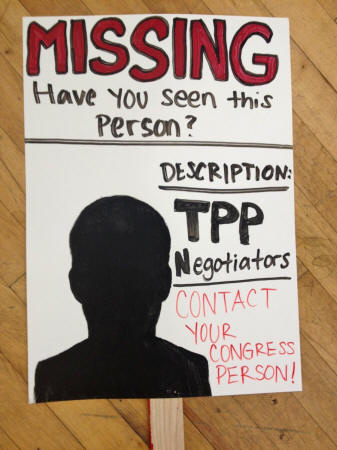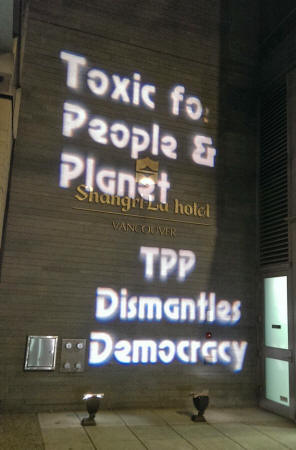|
News broke late last week in a few subscription-only, on-line, trade journals that while the next full round of negotiations of the Trans-Pacific Partnership (TPP) are slated to take place in Malaysia in mid-July,
Often occurring under the radar, intersessionals, meetings that take place between official TPP negotiations, are happening in advance of the session in Malaysia to try to keep the free trade talks on track for conclusion this fall.
Last month, negotiators of the ever controversial investment chapter met in Vancouver and were challenged with a teach-in on TPP, a night-time light projection of anti-TPP messages and a protest organized by the TPPxBorder Network.
Protest projection in Vancouver B.C. June 2013
A meeting in San Francisco on Rules of Origin?
As Arthur Stamoulis from the Citizens Trade Campaign explains,
We thought that the Rules of Origin negotiators would like to hear from former sweatshop worker Chie Abad, who once suffered under an earlier version of these Rules of Origin in the U.S. protectorate, Siapan.
Working for GAP, and other U.S. retailers through the SAKO garment factory, she sewed “Made in the USA” labels into clothing, yet enjoyed none of the worker protections which U.S. workers do.
In fact, she was fired for attempting to organize a union.
Again, Arthur explains how the TPP takes advantage of the experience Chie had, and make it worse,
Because the government of Vietnam, which promotes it’s country as a low-cost labor alternative to China, is siding with the major transnationals in pushing for much lower Rules of Origin than most other countries within the TPP negotiations, we’d heard that the Rules of Origin negotiations are very heated.
Despite photos of friendly handshakes after the recent full round in Lima, Peru, countries are far from reaching agreement, and continued disagreement over the chapter possesses the potential to sink the entire pact.
We tried for days to contact the Rules of Origin negotiators, but with no luck.
We called the top hotels in the city and found that not only did most people not know where the negotiatiors were meeting, they also didn’t know what the TPP is, so we decided to take to the streets and look ourselves (and do some public education at the same time!).
Here’s what happened:
The TPP - Where Are the Negotiators?
TAKE ACTION!
|


